The key to standing out in the crowded Amazon marketplace lies in the power of high-impact visuals and effective listing optimization. However, many sellers face common hurdles such as the high costs associated with traditional photography services, the complexities of using advanced tools like Photoshop, and the time-consuming nature of content creation in maximizing their amazon sales.
Additionally, the challenges extend to listing optimization, where expensive copywriting services, listings that fail to convert, and the high costs of running ads due to low conversion rates can significantly hinder a seller’s success.
In this article, we will explore how you can overcome these challenges by leveraging cost-effective visual strategies and an innovative tool: ProductScope AI. From crafting high-quality Amazon A+ content images on a shoestring budget to navigating the technical aspects of image optimization, we will guide you through each step of creating compelling product listings.
Whether you are a small business owner, a solo entrepreneur, or a marketer looking to boost your Amazon sales, this guide is tailored to provide you with actionable insights and strategies.
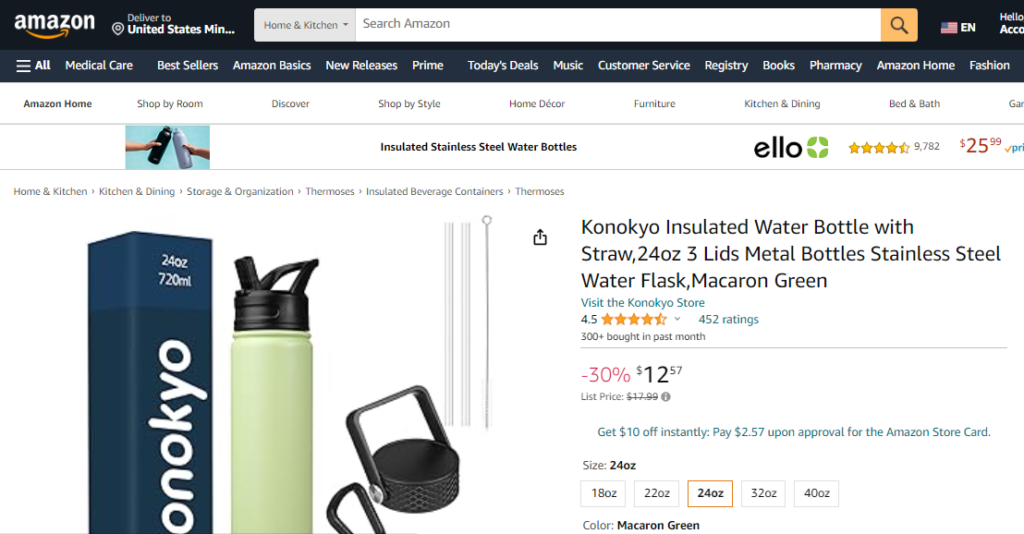
Challenges Faced on the Amazon Marketplace Landscape
The Amazon marketplace is not just a platform; it’s a vast, ever-changing ecosystem. It’s a place where millions of sellers vie for the attention of a diverse and global customer base. This environment is characterized by intense competition and constant evolution, driven by both seller innovation and Amazon’s own updates.
Capturing Customer Attention
With countless products and sellers vying for visibility, it is essential for sellers to understand their target audience and find ways to stand out from the crowd. This requires a deep understanding of customer preferences, needs, and desires.
To capture customer attention effectively, sellers must first conduct thorough market research to identify their target audience. By understanding their customers’ demographics, interests, and purchasing behaviors, sellers can tailor their product listings and marketing strategies accordingly. This knowledge allows them to create compelling product descriptions, eye-catching images, and persuasive advertising campaigns that resonate with their target customers.
However, simply understanding the target audience is not enough. Sellers must also master the art of standing out in a crowded marketplace.

Navigating Amazon’s Algorithms
Navigating Amazon’s algorithms is a crucial aspect of achieving success on the platform. These algorithms play a significant role in determining the visibility and ranking of products in search results. To stay ahead of the competition, sellers must constantly adapt their strategies to align with the ever-evolving algorithms.
Understanding how Amazon’s algorithms work is essential for optimizing product visibility. Factors such as customer behavior, search relevance, pricing, and seller performance all influence the algorithms’ decision-making process.
Sellers need to stay updated on any changes or updates to these algorithms and adjust their product listings accordingly. This may involve conducting keyword research to identify relevant and high-ranking keywords, optimizing product titles and descriptions with these keywords, and continuously monitoring and improving seller performance metrics.
The Importance of Effective Product Photography for Customer Attention
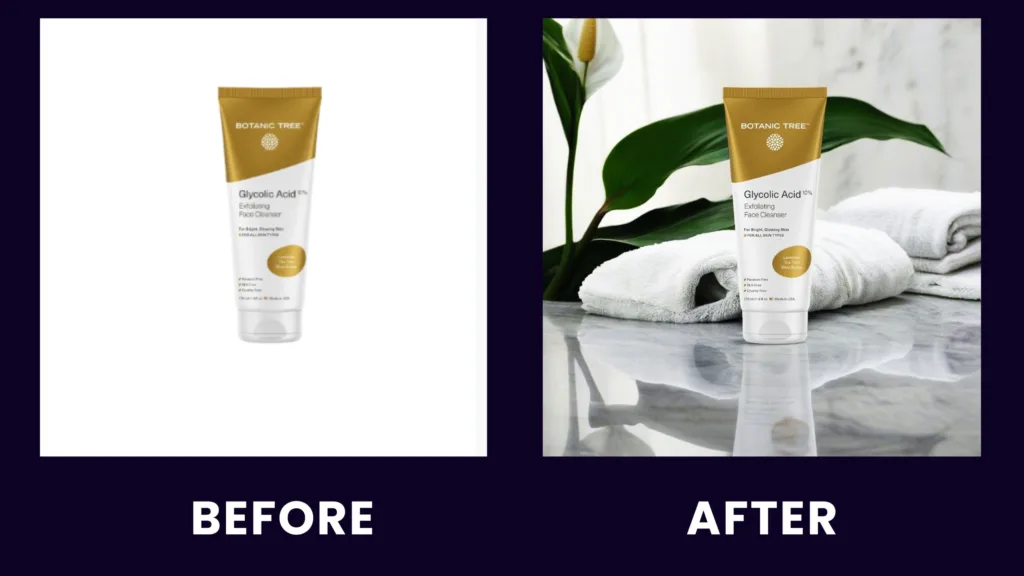
The First Impression Counts
When a potential customer browses Amazon, the first thing that catches their eye is the product image. This visual representation is not just a picture; it’s the frontline of your marketing strategy. High-quality, professional photos convey trust and quality, compelling customers to click on your product over others. Remember, you only have a few seconds to make a good first impression, and your product photography does exactly that.
A Picture is Worth a Thousand Words
In an online shopping environment, customers can’t touch or feel the product. Here, your product photography fills that sensory gap. It tells a story, showcasing the product in a way that words cannot. Through various angles, close-ups, and lifestyle images, you can convey the product’s quality, functionality, and how it fits into the customer’s life. This visual storytelling is key to influencing buying decisions.
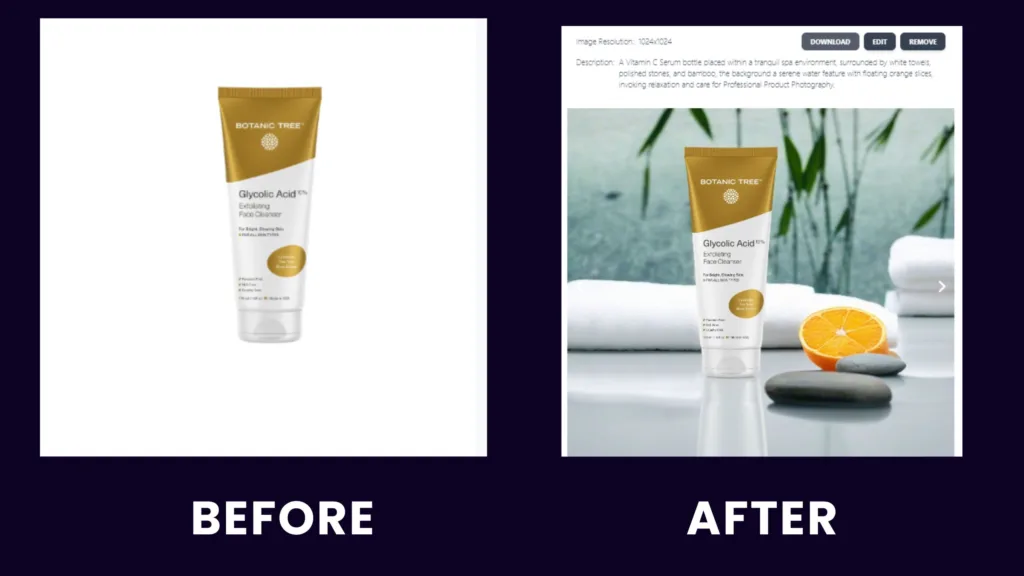
Enhancing Brand Image
Consistent and high-quality product photography also enhances your brand image. It reflects the professionalism and credibility of your brand, setting a standard for what customers can expect. This consistency in imagery helps in building a loyal customer base that trusts your brand and looks forward to new product launches.
Overcoming Online Shopping Limitations
One of the main challenges of online shopping is the inability to physically examine products. Effective product photography overcomes this by providing detailed, high-resolution images that offer a realistic view of the product. Images that highlight key features, textures, and usage scenarios help customers make informed decisions, reducing doubts and potential returns.
Standing Out in a Competitive Market
Amazon’s marketplace is fiercely competitive. To stand out, your product not only needs to be great but also look great. Innovative and creative product photography can set your product apart. This could mean using unique backgrounds, incorporating interesting props, or showcasing the product in unconventional ways. Such creativity captures customer attention and makes your product memorable.
Encouraging Social Shares
In today’s social media-driven world, visually appealing images are more likely to be shared. Customers often share products they like on platforms like Instagram, Pinterest, and Facebook. High-quality, attractive product images increase the likelihood of social shares, providing free marketing and reaching a wider audience.
Sign Up for ProductScope AI Today!
Common Problems in Product Photography for E-commerce Brands

In the rapidly evolving world of e-commerce, product photography plays a pivotal role in brand success. However, e-commerce brands, especially smaller ones, often grapple with several challenges in this arena.
1. High Costs of Traditional Photography Services and Studio Rentals
One of the primary hurdles is the significant expense associated with professional photography services. Hiring photographers, renting studios, and acquiring the necessary equipment can be prohibitively expensive, particularly for startups and small businesses. This high cost not only strains limited budgets but also restricts the frequency and diversity of product shoots, ultimately impacting the variety of content a brand can offer.
For example, a small e-commerce brand that specializes in handmade jewelry may struggle to afford the services of a professional photographer. The cost of hiring a photographer, renting a studio, and purchasing high-quality equipment can quickly add up, straining the brand’s limited budget.
As a result, the brand may be forced to limit the number of product shoots they can afford, hindering their ability to showcase a diverse range of products and effectively engage with customers.
2. Technical Skills Required for Editing Software
Post-production is an essential aspect of product photography, yet mastering software like Adobe Photoshop or Lightroom requires time and technical expertise. Many small business owners lack these skills and cannot afford to hire professional photo editors. This gap often leads to lower-quality images or a reliance on basic editing, which may not suffice in a highly competitive online marketplace where visual appeal is crucial.
Consider a startup clothing brand that lacks the technical expertise to edit product images using software like Adobe Photoshop. Without the necessary skills or resources to hire professional photo editors, the brand may resort to basic editing techniques or rely on free online tools. However, these options may not produce the desired level of quality and refinement needed to stand out in a competitive online marketplace.
In the end, the brand’s product images may appear subpar compared to those of their competitors, potentially impacting their ability to attract and convert customers.

3. Time-Consuming Nature of Content Creation
Creating high-quality product images is not just about taking photographs. It involves planning, setting up, shooting, editing, and optimizing for different platforms. This process is time-consuming and can be overwhelming for brands that do not have dedicated teams for content creation. Balancing this with other aspects of running a business can be challenging, leading to delays in product launches or marketing campaigns.
Imagine an e-commerce brand that sells home decor items. The process of creating high-quality product images involves meticulous planning, setting up props and backgrounds, capturing multiple shots from different angles, and post-production editing. This time-consuming process can be overwhelming for brands that do not have dedicated teams for content creation.
4. Limited Marketing Budgets
Smaller e-commerce brands often operate with constrained marketing budgets, making it difficult to allocate sufficient funds for professional product photography. This limitation can lead to a reliance on DIY photography, which may not always meet the standards required for a compelling online presence.
Take the example of a small beauty brand that operates on a tight marketing budget. Allocating sufficient funds for professional product photography may be challenging, forcing the brand to rely on DIY photography methods.
While this approach may save costs initially, it may not always meet the standards required for an impactful online presence. The brand may struggle to create visually appealing images that effectively showcase their products, potentially limiting their ability to attract and retain customers in a highly competitive market.

5. Keeping Up with Trends and Consumer Expectations
The e-commerce landscape is dynamic, with constantly evolving trends and consumer preferences. Brands need to regularly update their product imagery to stay relevant and appealing. However, keeping up with these trends can be difficult, especially when dealing with the aforementioned challenges.
Consider an e-commerce brand that sells trendy fashion accessories. The fashion industry is known for its rapidly changing trends and consumer preferences. To stay relevant and appealing, the brand needs to regularly update their product imagery to align with the latest styles and aesthetics. However, this can be a daunting task, especially when faced with the challenges of limited resources, technical skills, and time constraints.
Failing to keep up with trends may result in outdated product images that fail to resonate with target customers, impacting the brand’s ability to drive sales and maintain a competitive edge.
6. Consistency in Brand Image
Maintaining a consistent brand image across all product photos is crucial but challenging. Different lighting, angles, and editing styles can lead to a disjointed appearance in the online store, potentially confusing customers and diluting the brand message.
Imagine an e-commerce brand that offers a wide range of home appliances. Maintaining a consistent brand image across all product photos can be challenging, particularly when different photographers, lighting conditions, angles, and editing styles are involved.
Inconsistencies in product imagery can create a disjointed appearance on the brand’s online store, potentially confusing customers and diluting the brand message. Achieving visual coherence and consistency becomes crucial for establishing a strong brand identity and fostering customer trust.
7. Scaling Photography with Business Growth
As a brand grows, its product range often expands, necessitating more photography. Scaling photography efforts to match business growth, while maintaining quality and consistency, can be a daunting task for many e-commerce brands.
Consider a rapidly growing e-commerce brand that started with a small product range but is now expanding into various categories. As the brand introduces new products, the need for photography increases exponentially. Scaling photography efforts to match this growth while maintaining quality and consistency can be overwhelming without the right tools and processes in place.
Without an efficient solution, the brand may struggle to keep up with the demand for visually appealing product images, potentially hindering their ability to effectively showcase their expanded product range and capitalize on new market opportunities.
How ProductScope AI Product Photoshoot Tool Can Help
ProductScope AI offers an innovative solution for product photography, particularly with their AI Photoshoot feature. This tool allows users to reimagine the context of their product images completely.
For instance, you can envision your product in various settings, such as on a sunlit breakfast table, in a cozy reading nook, or even on a mountain summit for more adventurous themes. The key advantage of ProductScope AI’s service is its ability to generate high-quality images based on AI prompts, enabling users to create their dream product settings.
Here’s how ProductScope AI can address each of the common problems in product photography for e-commerce brands:
Reducing Costs of Photography and Studio Rentals
ProductScope AI significantly lowers the cost of product photography. By using AI to generate realistic backdrops, brands can create professional-quality images at a fraction of the cost of traditional photoshoots, sometimes as low as 1/100th of the cost, without compromising on quality.
Say goodbye to hefty photography and studio rental fees with ProductScope AI. Our AI technology crafts realistic scenes, enabling you to produce top-tier images at a fraction of traditional costs – sometimes saving up to 99%! This significant cost reduction frees up your budget for other vital areas like marketing and product development, without sacrificing image quality.
ProductScope’s AI-generated scenes are not only cost-effective but also strikingly realistic, ensuring your product images are professional and meet the highest standards.
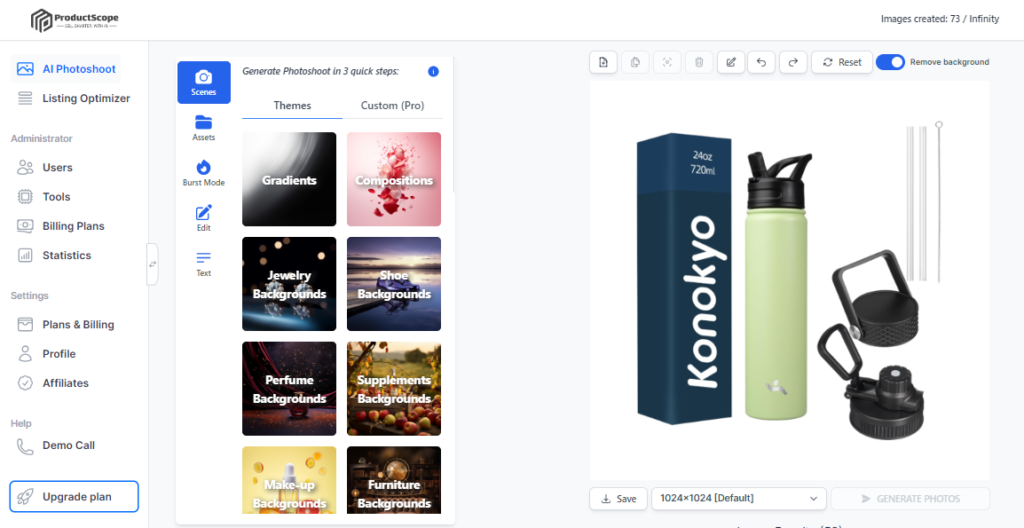
Simplifying Technical Skills Requirement
The traditional process of photo editing often requires individuals to possess a deep understanding of complex software like Photoshop, which could be intimidating and time-consuming for many.
However, with the advent of AI-driven technology, the need for extensive technical skills in photo editing software is eliminated. Users can now simply describe their desired setting or effect, and the AI takes care of generating the backdrop accordingly.
Gone are the days of mastering complex software for photo editing. ProductScope AI simplifies this process. Just describe your desired backdrop, and our AI will bring it to life. This advancement opens doors for those without the time or skill to navigate intricate editing software, allowing anyone to create breathtaking images effortlessly.
Streamlining Content Creation
ProductScope AI speeds up the content creation process. Instead of the time-consuming tasks of planning, shooting, and editing, brands can quickly generate a variety of high-quality images, allowing for more efficient marketing content production.
With ProductScope AI, streamline your content production. Quickly generate diverse, high-quality images, making your marketing efforts more efficient and effective.
Optimizing Limited Marketing Budgets
With its cost-effective solution, ProductScope AI is particularly beneficial for smaller brands with limited marketing budgets. It enables these brands to produce professional-grade product images without a significant financial investment.
Our solution is a boon for smaller brands with tight budgets. ProductScope AI enables these businesses to produce top-notch product images without breaking the bank.

Adapting to Trends and Consumer Expectations
The flexibility of AI-generated backdrops allows brands to quickly adapt to changing trends and consumer preferences. Brands can easily update their product imagery to stay relevant and appealing in the dynamic e-commerce landscape.
At our brand, we understand the importance of keeping up with the latest trends and meeting consumer expectations. With AI-generated backdrops, we have the power to easily update our product imagery to reflect these changes.
Whether it’s a new color palette, a popular theme, or a seasonal trend, we can swiftly incorporate these elements into our visuals, ensuring that our products remain relevant and appealing to our target audience.
Ensuring Consistency in Brand Image
ProductScope AI can help maintain a consistent brand image across all product photos. The AI ensures that lighting, angles, and styles are uniform, providing a cohesive look across the brand’s online presence.
With the help of ProductScope AI, we can effortlessly achieve this goal by ensuring that all our product photos adhere to a unified style and aesthetic. The AI technology meticulously analyzes lighting, angles, and styles, guaranteeing that every image reflects our brand’s essence and values.
Scaling Photography with Business Growth
As a brand experiences growth, it often finds itself faced with the challenge of producing a larger volume of product images. This increased demand for photography can be overwhelming and time-consuming, especially if not managed efficiently. However, with ProductScope AI’s scalable solution, brands can easily meet this challenge by expanding their volume of product images while maintaining quality and consistency.
ProductScope AI understands the importance of maintaining a high standard of visual representation for a brand’s products. By leveraging its advanced technology, brands can streamline their photography process and efficiently scale their image production.
The AI-powered solution automates various aspects of the photography workflow, such as image editing, resizing, and formatting, allowing brands to handle a larger volume of images without compromising on quality. This scalability ensures that as a brand grows and introduces new products to its range, it can effortlessly keep up with the demand for visually appealing and consistent product imagery.
Sign Up for ProductScope AI Today!
Step-by-Step Guide to Use ProductScope Product Photoshoot
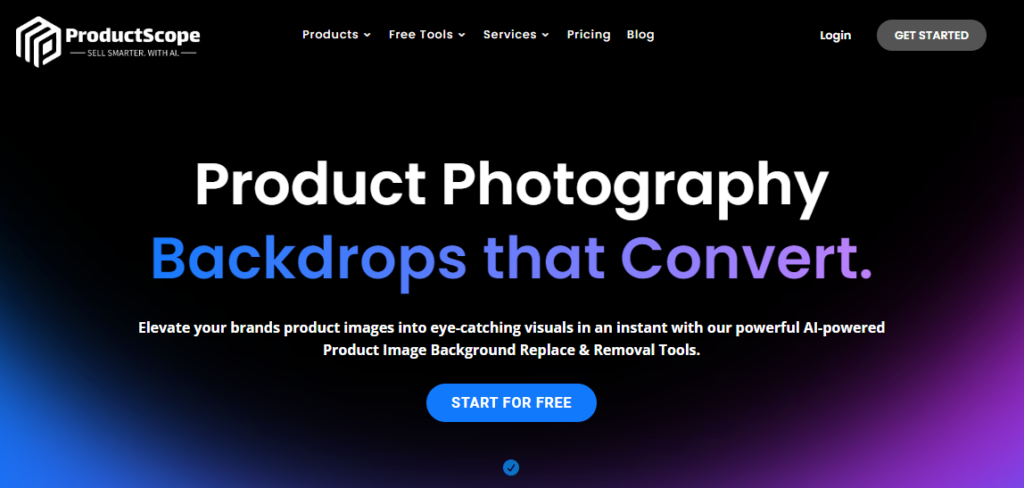
Using the Ready-to-Use Themes of the Custom prompt themes
Step 1. First, you have to go to your Amazon account and click on ProductScope’s Chrome extension to autimatically add your product image in the assets or simply add image into your assets and start from there.
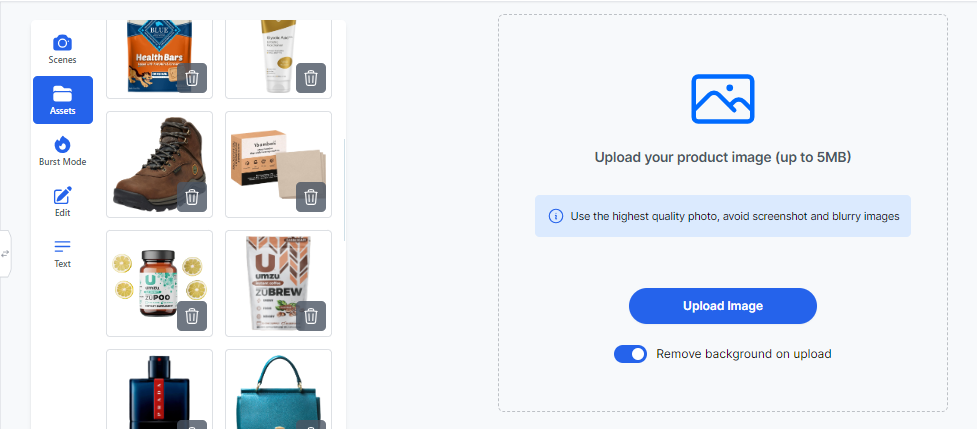
Step 2. Next, click on the ready-to-use theme or create your own background idea using the prompt feature.
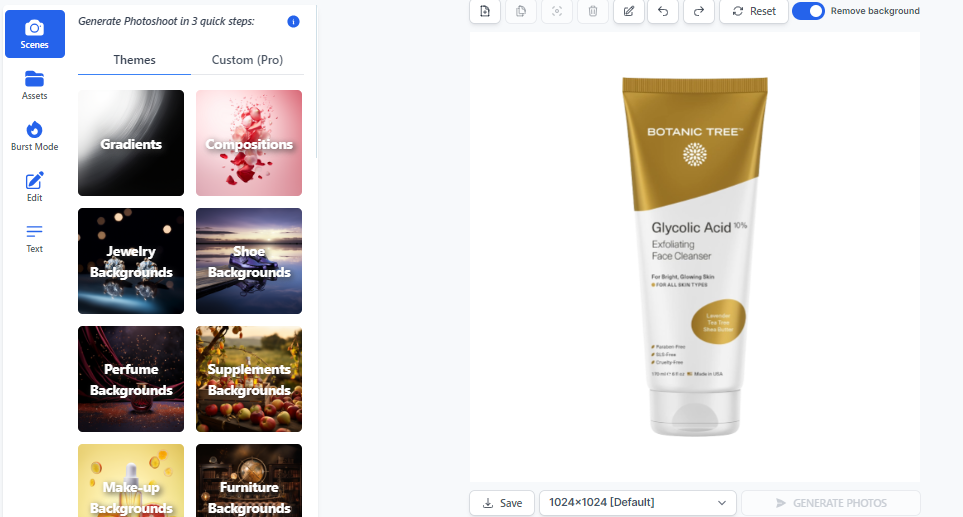
Step 3. Begin by selecting any of the images that have been automatically generated and displayed for you. Once you’ve chosen an image, proceed to position your product within it, placing it exactly where you desire. This step is crucial for ensuring that your product is showcased in the most effective and visually appealing manner.

Step 4: Additionally, you have the flexibility to adjust the size of the image to better fit your needs. Whether you need to enlarge or reduce the image, these adjustments can be easily made to ensure the product is displayed correctly.
Step 5: If the orientation of the image isn’t quite right, you have the option to flip it. using the EDIT feature. This can be particularly useful for achieving the perfect angle or perspective.

Step 6: If you want to erase a certain part of the image, you can simply use the ERASE feature. And want to replace it with something else, judt use the REDRAW feature.
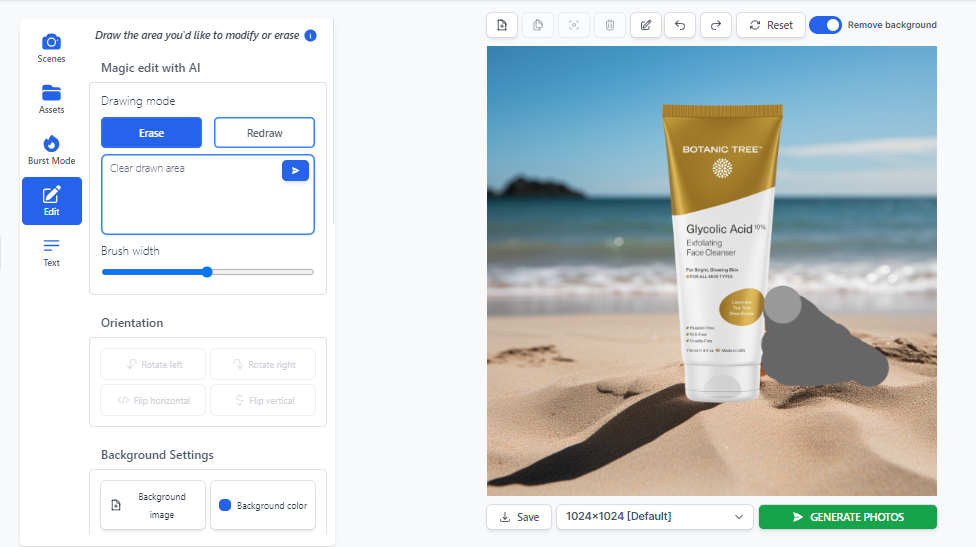
Step 5. Then click on the Generate Image feature to see the final results.
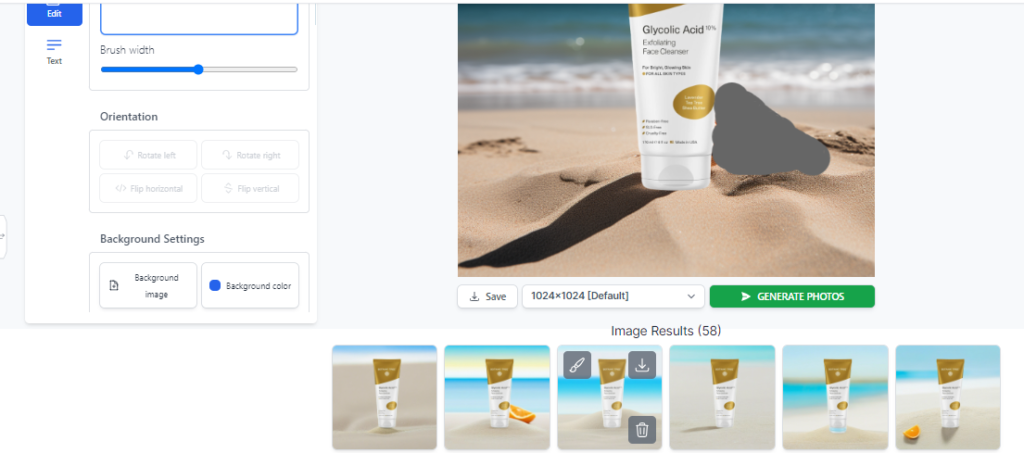
Using Burst Mode
Burst Mode is an advanced feature of ProductScope Photoshoot tool where you can generate a minimum of 10 product photos in just one click.
Here are the steps to use it.
Step 1. You need to select your image from your Amazon or from your added assets.
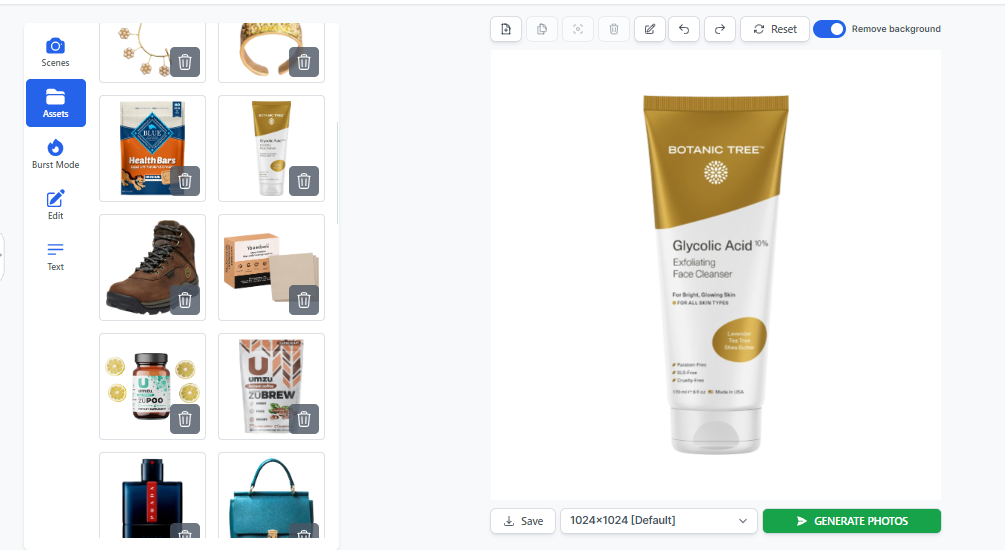
Step 2. Next, got to burst mode feature and put the name of your product and other important details about your product you want AI to take note of. Say for example, your product is for skin care. You might need to make sure the AI knows it actually does for the skin or what specific skin care it is.
Note: The more specific, the better.
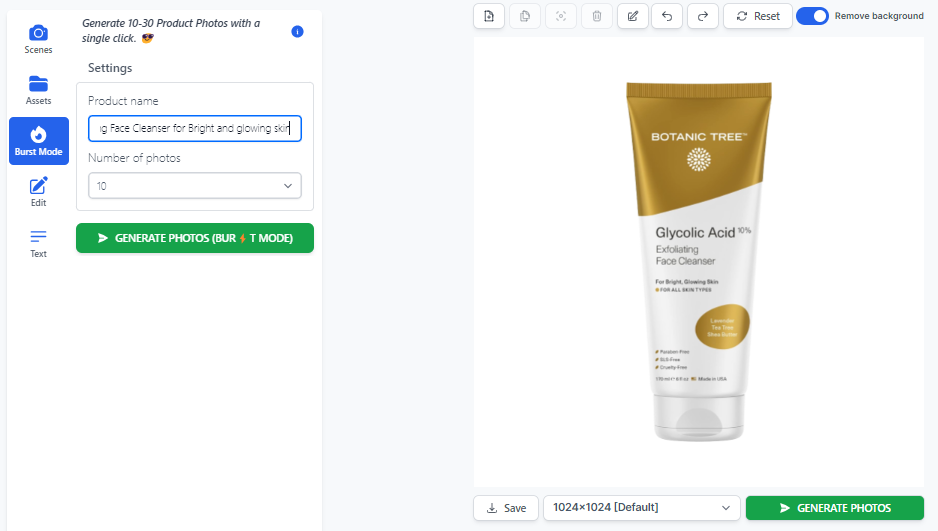
Step 3. Select the number of images you want to generate. Ranging from 10 to 30 images in one go.

Step 4. Click “Generate” And that’s it. You have your instant product photo in one click.
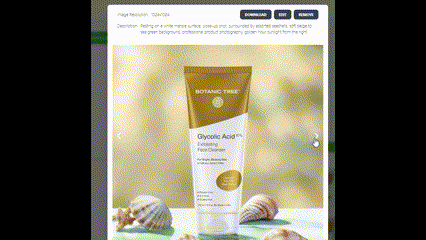
Importance of Navigating Amazon’s Algorithms

At the heart of Amazon’s marketplace is the A9 algorithm, a sophisticated system that determines which products appear in search results and in what order. This algorithm is influenced by a multitude of factors, including keyword relevance, customer reviews, price, and sales history.
By understanding the intricacies of A9, sellers can optimize their listings to rank higher, thereby increasing visibility and sales potential.
The Power of Visibility
Visibility on Amazon is akin to having your product displayed in the front window of a high-street store. The higher your product ranks, the more likely it is to be seen and purchased by potential customers. Navigating Amazon’s algorithms effectively ensures that your product doesn’t get lost in the sea of listings but instead stands out to your target audience.
Conversion Rate Optimization
Amazon’s algorithms favor products that not only attract clicks but also convers these clicks into sales. This is where Conversion Rate Optimization (CRO) comes into play. By optimizing product titles, images, descriptions, and pricing, you can enhance the likelihood of conversions. High conversion rates signal to Amazon that your product is popular and relevant, further boosting your search ranking.
Leveraging Customer Feedback
Customer reviews and ratings are a critical component of Amazon’s algorithms. Positive feedback not only instills trust in potential buyers but also signals to Amazon that your product is of high quality, which can improve your ranking. Actively managing customer feedback, addressing concerns, and maintaining high-quality standards are crucial for algorithmic success.
Staying Ahead of the Game
Amazon’s algorithms are not static; they are constantly being updated and refined. Staying informed about these changes and adapting your strategy accordingly is vital. This means regularly updating your listings, experimenting with different keywords, and keeping an eye on the competitive landscape.
How ProductScope AI Listing Optimization Can Help
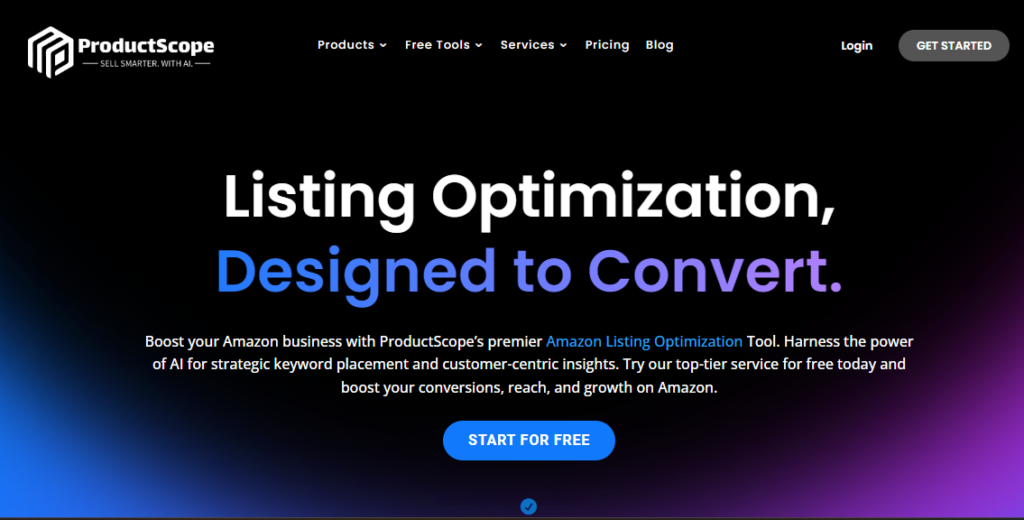
Navigating Amazon’s algorithms for optimal product visibility and sales can be a daunting task for sellers. This is where ProductScope AI Listing Optimization tool steps in as a game-changer. Let’s explore how this tool can revolutionize your Amazon listing strategy.
Strategic Keyword Integration
Mastering Amazon SEO is more than just adding relevant keywords; it’s about strategic placement, frequency, and relevancy. ProductScope’s Amazon Listing Optimizer uses a unique approach to blend high-impact keywords with insights specific to your customers.
It understands the language your customers use and their search behaviors, allowing for the natural integration of keywords into your listings. This method enhances your visibility and ranking on Amazon, moving beyond keyword stuffing to create content that is both engaging and SEO-optimized.
Enhanced SEO Optimization
By analyzing customer language and search patterns, ProductScope AI ensures that your product listings are not only keyword-rich but also relevant and engaging. This increases the likelihood of your product ranking higher in Amazon search results.
By incorporating the right keywords and phrases that customers are actively searching for, we can improve our visibility and attract more potential buyers. The AI technology’s ability to analyze customer language and search patterns ensures that our product listings are not only keyword-rich but also relevant and compelling, increasing the chances of our products appearing at the top of search results.
Moreover, by leveraging ProductScope AI for enhanced SEO optimization, we can stay ahead of our competitors. The AI technology provides us with valuable insights into customer behavior and preferences, allowing us to adapt our product listings accordingly. This ensures that we are always in tune with what our target audience is looking for, giving us a competitive edge in the market.
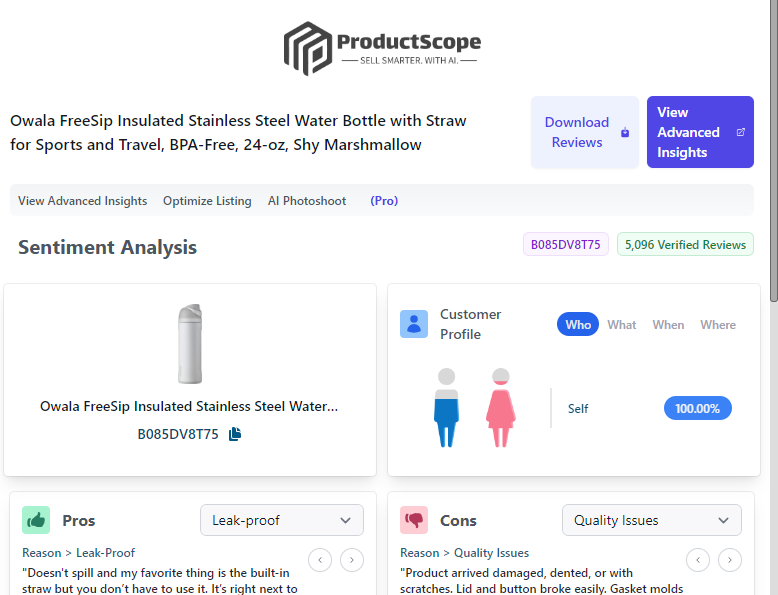
Customer-Centric Approach
With the help of ProductScope AI, we can ensure that our product listings are specifically tailored to speak directly to our target audience. By analyzing customer insights and understanding their preferences, the AI technology enables us to create listings that resonate with our customers on a deeper level. This personalized approach not only improves engagement but also increases conversion rates.
ProductScope AI’s customer-centric approach allows us to gain valuable insights into our target audience’s behavior, preferences, and language. By understanding what motivates our customers and what they are looking for in a product, we can craft listings that address their needs and desires effectively. This tailored approach not only captures their attention but also builds trust and credibility, increasing the likelihood of them making a purchase.
With ProductScope AI, we can create listings that speak directly to our customers, ensuring that they feel understood and valued.
Avoiding Keyword Stuffing
Traditional keyword stuffing can harm your SEO efforts. ProductScope AI optimizes keyword usage in a way that is natural and effective, ensuring your listings are favored by both Amazon’s algorithms and potential customers.
ProductScope AI understands the importance of striking the right balance when it comes to keywords. By analyzing customer insights and search trends, AI technology helps us identify the most relevant and impactful keywords for our listings. It then optimizes their usage in a way that seamlessly integrates them into our content, making it more appealing to both Amazon’s algorithms and potential customers. This approach ensures that our listings are not only favored by search engines but also resonate with our target audience, leading to higher visibility and increased conversions.
By leveraging the power of ProductScope AI, we can optimize our listings without resorting to keyword stuffing. This not only helps us maintain good standing with search engines but also enhances the user experience for our customers.
Step-by-Step Guide to Using ProductScope Listing Optimizer
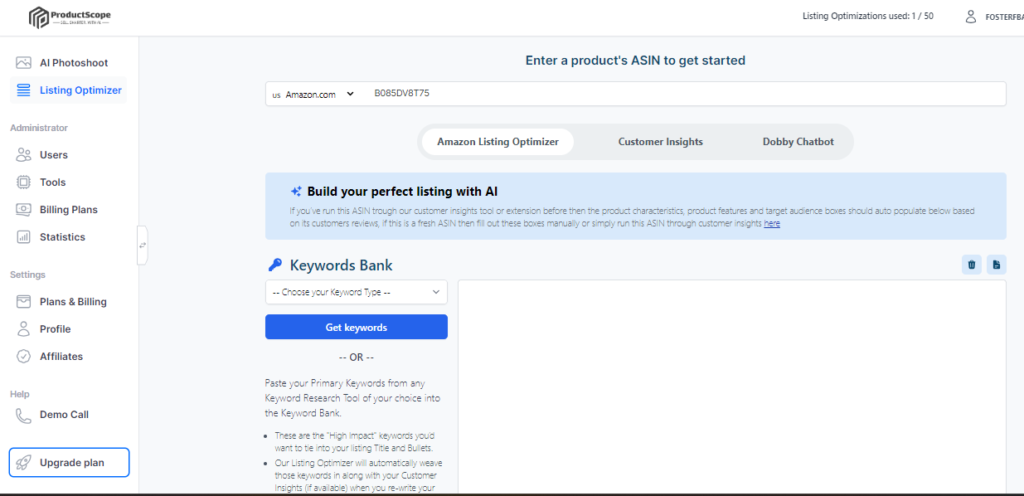
Step 1: Getting Started with Your Product
First things first, let’s get your product into the system. If you’re already on ProductScope, great! Just pop in the ASIN of your product – that’s the unique code Amazon uses to identify each item. Or, if you’re browsing your product on Amazon, you can use the handy Chrome extension. Just click on “Optimize Listing” and you’re off to a good start. Think of it like giving your product a quick and easy passport to better sales.
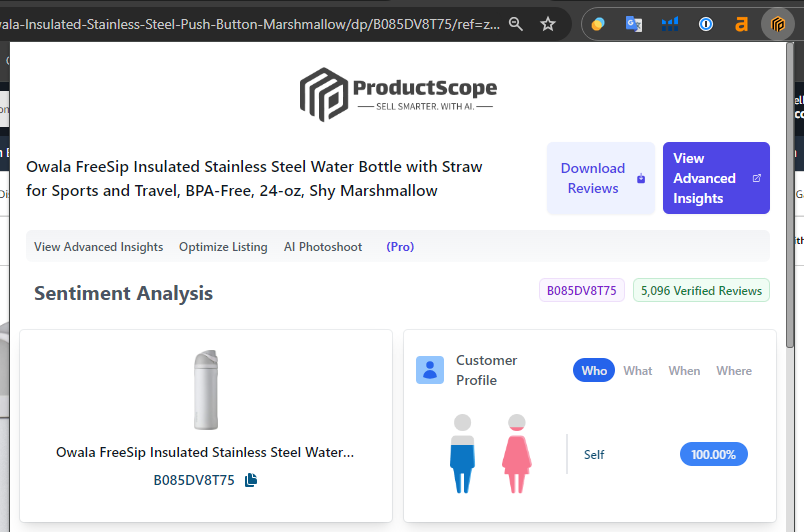
Step 2: Finding the Right Words
Now, let’s talk about keywords. These are like the secret sauce to getting your product noticed. Dive into some keyword research based on what you think your customers are looking for. ProductScope lets you play around with different types of keywords. It’s like being a detective, figuring out exactly what words will make your product stand out. Just click
For example, if you’re selling a yoga mat, you might look for keywords like ‘eco-friendly’, ‘non-slip’, or ‘extra cushioned’.

Step 3: Choosing Your Keywords Wisely
Here’s where it gets exciting. Use the “Primary” keyword type in ProductScope to generate a list of keywords for your Amazon Listing. It’s a bit like picking the right ingredients for a recipe – you can add or remove keywords until it feels just right. If we stick with the yoga mat example, you might end up with keywords like ‘durable’, ‘lightweight’, and ‘easy to clean’.

Step 4: The Finishing Touches
Our Listing Optimizer will automatically weave those keywords in along with your Customer Insights (if available) when you re-write your listing.
Now, take a look at your current product title, descriptions, and features. With ProductScope, you can hit “Rewrite for me” and watch as it transforms your listing using your chosen keywords. It’s like having a personal editor who knows exactly how to make your product irresistible to shoppers.
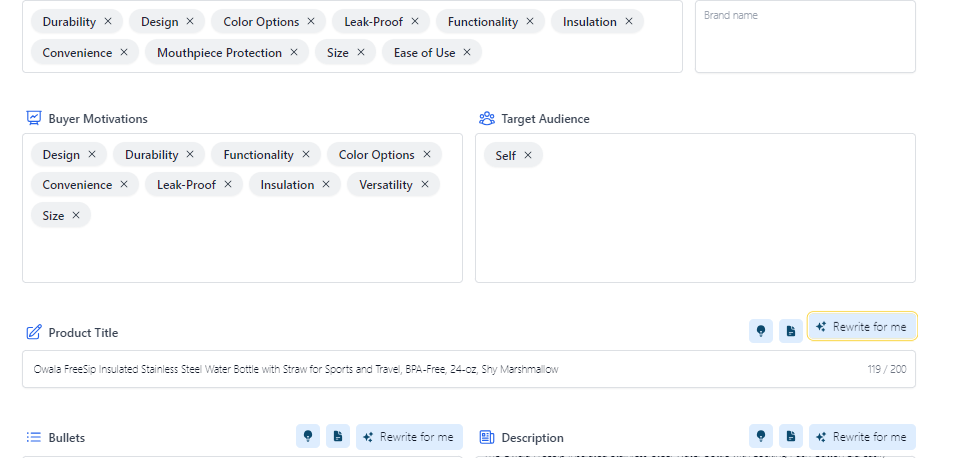
Step 6: Bringing It All Together
Almost done! Once you’re happy with everything, you can print out the new, optimized content as a PDF. Then, simply update your actual Amazon listing with this new content. It’s like putting the final pieces of a puzzle together, and the picture is your product, shining bright and ready to attract more customers.

Overcoming Challenges in Content Creation and Listing Optimization

Cost-Effective Content Creation
Traditional photography and content creation can be prohibitively expensive, especially for small to medium-sized businesses. ProductScope AI revolutionizes this process by offering a more affordable solution.
By utilizing advanced AI algorithms, it can generate high-quality images and content that are on par with professional photography, but at a fraction of the cost. This democratizes access to top-tier marketing materials, allowing smaller sellers to compete with larger ones on a more level playing field.
ProductScope AI leverages advanced artificial intelligence to automate the content creation process. This tool can generate high-quality product images, engaging descriptions, and compelling feature highlights. By using AI, ProductScope reduces the need for expensive professional photography and copywriting services, making it an ideal solution for businesses looking to produce premium content on a budget.
Enhanced Listing Optimization
The key to success on Amazon lies in how effectively a product is presented. ProductScope AI doesn’t just stop at creating visually appealing content; it also optimizes product listings. This involves using AI to analyze keywords, trends, and competitor data to ensure that your product stands out in search results. By optimizing titles, descriptions, and keywords, ProductScope AI can significantly improve a product’s visibility on Amazon.
ProductScope AI excels in optimizing product listings by analyzing vast amounts of data. It uses machine learning algorithms to identify the most effective keywords, analyze competitor listings, and understand current market trends. This ensures that your product listings are not only SEO-friendly but also tailored to appeal to your target audience. As a result, your products gain better visibility and ranking on Amazon’s search engine.
Improved Conversion Rates
Attracting customers to your listing is only half the battle; the next step is converting them into buyers. ProductScope AI enhances this aspect by creating content that is not only visually appealing but also tailored to resonate with your target audience.
By analyzing customer behavior and preferences, it can produce content that speaks directly to the needs and desires of potential buyers, thereby increasing the likelihood of conversion.
One of the standout features of ProductScope AI is its ability to create personalized content that resonates with specific customer segments. ProductScope can tailor the product descriptions and images to match the preferences of your target audience. This personalization leads to a higher engagement rate and, consequently, better conversion rates.
Reducing Dependency on Large Marketing Budgets
One of the biggest challenges for sellers on Amazon is competing against entities with substantial marketing budgets. ProductScope AI levels the playing field by providing high-quality content and optimization services that were previously only accessible to those with significant resources. This means that even sellers with limited budgets can now access tools and services that can catapult their products to the top of Amazon’s search results.
For small to medium-sized enterprises, managing marketing budgets is a crucial aspect. ProductScope AI provides a cost-effective alternative to traditional marketing methods. Its AI-driven approach minimizes the need for large investments in content creation and SEO optimization services, allowing businesses to allocate their resources more efficiently.
Continuous Learning and Adaptation
The digital marketplace is ever-evolving, and staying ahead requires constant adaptation. ProductScope AI is designed to learn continuously from market trends, customer feedback, and performance data. This ensures that your content and listings remain relevant and effective, adapting to changes in consumer behavior and market dynamics.
Case Studies and Sucess Stories of Using AI for Product Photoshoots and Listing Optimization

Increased Conversion Rates
AI product photography has been shown to help businesses increase their conversion rates. For example, Shopify found that using AI for product photography improved conversion rates by an average of 15%. This is partly due to AI’s ability to automate up to 75% of current product image workflows, allowing for a more efficient process.
Cost Reduction and Higher ROI
AI significantly reduces costs associated with traditional photography, such as studio costs, which can be cut by up to 60%. Moreover, AI improves marketing ROI by 15-25% in most companies, as per a Salesforce survey. The technology enables businesses to pay reasonable monthly subscriptions instead of large upfront photography spending.
Customization and Quality
AI allows for the production of unlimited colors, mixes, crops, and image compositions, offering a high level of customization. Additionally, AI ensures visual consistency across product images and can automatically apply brand guidelines. Advanced AI systems, like generative adversarial networks (GANs), can create product images with life-like materials and natural lighting.
Time Efficiency and Accelerated Market Entry
With AI, businesses can experience a 10-30x faster turnaround in product photography, enabling them to launch new products and updates more swiftly. This speed in bringing products to market can be a significant competitive advantage.
Conclusion
Combining high-impact visual strategies with the innovative capabilities of ProductScope AI represents a new frontier in Amazon listing optimization. By embracing these tools and techniques, sellers can enhance their listings, attract more customers, and increase sales, all while keeping costs in check.
Transform your Amazon listings with ProductScope AI! Unleash creativity with AI-powered photography backdrops, bringing your products to life in any setting you imagine. Elevate your visibility with our Amazon Listing Optimization Tool, strategically integrating keywords for maximum impact. Embrace innovation, boost your sales, and outshine competitors. Start now at ProductScope AI – where imagination meets optimization!
FAQs
What Is Productscope AI and How Does It Help Amazon Sellers?
ProductScope AI is an innovative tool designed to assist Amazon sellers in creating high-quality product listings. It offers solutions for cost-effective visual strategies and listing optimization, catering to sellers with limited marketing budgets or resources.
Why Is High-Quality Product Photography Important on Amazon?
High-quality product photography is crucial because it’s often the first thing a potential customer notices. It conveys trust and quality, influences buying decisions, and helps your product stand out in a crowded marketplace.
What are the common challenges faced by e-commerce brands in product photography?
E-commerce brands often struggle with the high costs of professional photography, the technical skills required for editing software, the time-consuming nature of content creation, limited marketing budgets, and the need for consistency in brand imagery.
How Does Productscope AI Reduce the Costs and Complexities of Product Photography?
ProductScope AI uses AI technology to generate realistic backdrops and images, reducing the need for expensive photography services, studio rentals, and technical editing skills. It allows for the creation of professional-quality images at a fraction of the cost.
Can Productscope AI Help With Listing Optimization on Amazon?
Yes, ProductScope AI assists in listing optimization by analyzing keywords, trends, and competitor data. It optimizes product titles, descriptions, and keywords to improve visibility and ranking on Amazon.
How Does Productscope AI Improve Conversion Rates for Amazon Listings?
ProductScope AI enhances conversion rates by creating content that resonates with the target audience. It analyzes customer behavior and preferences to produce tailored descriptions and images that increase the likelihood of conversion.
What Is the Importance of Navigating Amazon’s Algorithms for Product Listings?
Navigating Amazon’s algorithms is essential for product visibility and ranking. Understanding factors like keyword relevance, customer reviews, and pricing helps optimize listings to rank higher, increasing visibility and sales potential.
How Does Productscope AI Ensure Consistency in Brand Image Across Product Photos?
ProductScope AI maintains a consistent brand image by ensuring uniform lighting, angles, and styles across all product photos, providing a cohesive look for the brand’s online presence.
What Are the Benefits of Using AI for Product Photoshoots and Listing Optimization?
Benefits include increased conversion rates, cost reduction, higher ROI, customization and quality of images, time efficiency, and accelerated market entry for new products.
How Can Small to Medium-Sized Businesses Benefit From Using Productscope AI?
Small to medium-sized businesses can benefit from ProductScope AI by accessing high-quality content and optimization services at a lower cost, reducing dependency on large marketing budgets, and staying competitive in the Amazon marketplace.
How to increase your online sales?
Increasing your online sales involves a multi-faceted approach: firstly, optimize your website for user experience and speed to ensure visitors can easily navigate and make purchases. Implement SEO best practices to increase organic traffic. Utilize social media marketing to engage with customers and drive traffic back to your website. Additionally, consider using email marketing campaigns to keep your audience informed and interested in your products. Offering promotions, discounts, or bundled deals can also entice purchases. Finally, make sure to analyze your data regularly to understand customer behavior and refine your strategies accordingly.
How do I get more customers for my online business?
To attract more customers to your online business, start by enhancing your online presence through effective SEO techniques that improve your visibility in search engine results. Engage with potential customers on social media platforms by sharing content that adds value and encourages interaction. Invest in paid advertising, such as PPC (pay-per-click) and social media ads, to target specific demographics. Building an email list and sending out newsletters and promotions can also draw in and retain customers. Offering excellent customer service and incentives for referrals can further expand your customer base.
How to sell online effectively?
Selling online effectively requires a clear understanding of your target audience and their needs. Ensure your website design is clean, professional, and mobile-friendly, as a significant amount of online shopping is done via smartphones. Utilize high-quality product images and detailed descriptions to help customers make informed decisions. Implement reliable payment gateways to ensure secure transactions. Utilize social proof like customer reviews and testimonials to build trust. Additionally, adopt digital marketing strategies such as SEO, content marketing, and social media engagement to drive traffic and convert leads into sales.
How to double online sales?
Doubling online sales can be achieved by first analyzing your current sales performance and identifying areas for improvement. Optimize your website for conversion rate by ensuring a seamless checkout process and using A/B testing to refine user experience. Expand your reach by exploring new market segments or international markets if applicable. Increase customer retention through loyalty programs, regular engagement, and personalized marketing. Leverage upselling and cross-selling opportunities during the purchasing process. Investing in advanced analytics tools can help you understand consumer behavior and tailor your marketing efforts to be more effective, thereby potentially doubling your sales.
How to Maximize Your Amazon Sales Without Breaking the Bank?
To maximize your Amazon sales without overspending, start by optimizing your product listings with high-quality images, detailed descriptions, and SEO-friendly titles. Utilize Amazon’s advertising options like Sponsored Products and Sponsored Brands judiciously, beginning with a modest budget. Enroll in Fulfilled by Amazon (FBA) to make your products Prime eligible, enhancing visibility and appealing to a broader customer base. Actively encourage customer reviews within Amazon’s guidelines and manage your inventory carefully to avoid stockouts or excess. Keep your pricing competitive with automated repricing tools and consider expanding your product range to include complementary items. Implement promotions and discounts strategically, especially during peak shopping periods. Regularly analyze your sales data to identify trends and refine your strategies, and if you’re brand registered, take full advantage of Amazon Brand Registry benefits like A+ Content to enhance your brand’s presentation and appeal. By following these cost-effective strategies, you can significantly boost your sales on Amazon.

